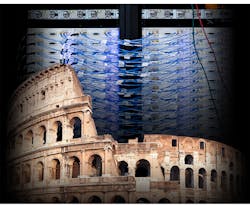Just like its counterpart in antiquity, DARPA’s version of the Colosseum involves competition. But in place of gladiator contests, this new Colosseum hosts efforts to conquer the electromagnetic (EM) environment. More precisely, it is an EM emulation chamber constructed in the Applied Physics Laboratory (APL) of Johns Hopkins University in Laurel, Md.
DARPA’s Colosseum is serving as the test bed for the agency’s Spectrum Collaboration Challenge (SC2), in which design teams are tasked with developing new ways of adapting radio communications systems to the shrinking availability of frequency spectrum. One of the approaches involves dynamic allocation of available spectrum via the autonomous collaboration of different wireless networks.
This Colosseum consists of multiple software-defined radios (SDRs) that generate the multiple signals of a severely overcrowded radio environment. It is essentially a nearly impossible EM environment for operating an additional radio system. A total of 128 two-antenna SDRs supplied by National Instruments are combined with 64 field-programmable gate arrays (FPGAs) to create a 256 × 256 channel emulator capable of calculating and simulating as many as 65,000 channel interactions among 256 wireless devices in real time.
Each simulated channel is designed to occupy 100 MHz, so that the testbed can occupy as much as 25.6 GHz of bandwidth at any one time. Transmit and receive frequencies can be tuned from 10 MHz to 6 GHz and has much as 52 TB of data can be transferred through the testbed in any second.
The test bed combines the SDR technology with a cloud-computing environment equipped with artificial intelligence (AI) to emulate countless different EM radio environments. “Putting such a powerful wireless testbed into the cloud is a first-of-its-kind achievement in and of itself,” noted SC2 program manager Paul Tilghman. “We are asking SC2 competitors to devise fundamentally new radio systems that can learn from each other in real-time, making the need for arduous radio specifications obsolete.”
As part of the SC2 competition, radio design teams must develop a radio system capable of operating with high performance levels in this spectrally saturated environment. A successful design team with a radio that provides the highest reliability under these challenging conditions stands to win as much as $3,500,000.
About the Author
Jack Browne
Technical Contributor
Jack Browne, Technical Contributor, has worked in technical publishing for over 30 years. He managed the content and production of three technical journals while at the American Institute of Physics, including Medical Physics and the Journal of Vacuum Science & Technology. He has been a Publisher and Editor for Penton Media, started the firm’s Wireless Symposium & Exhibition trade show in 1993, and currently serves as Technical Contributor for that company's Microwaves & RF magazine. Browne, who holds a BS in Mathematics from City College of New York and BA degrees in English and Philosophy from Fordham University, is a member of the IEEE.


